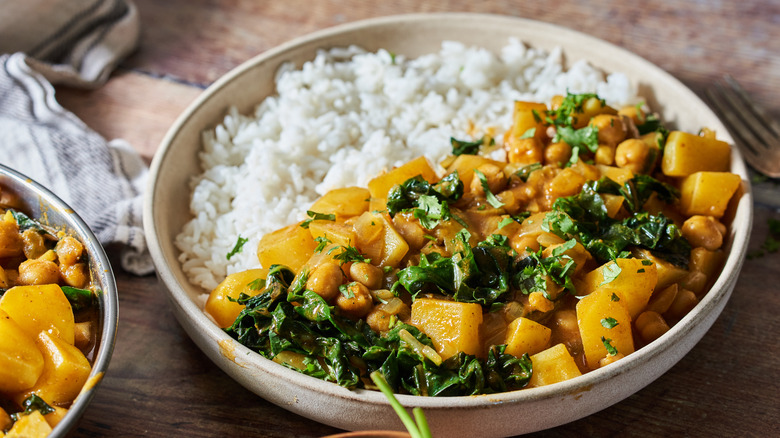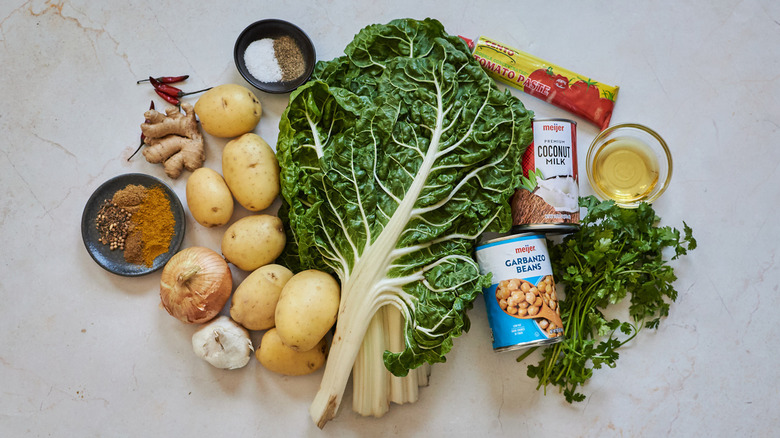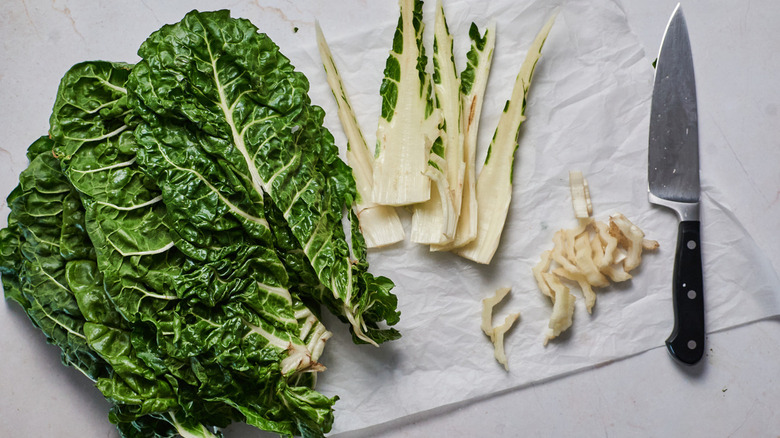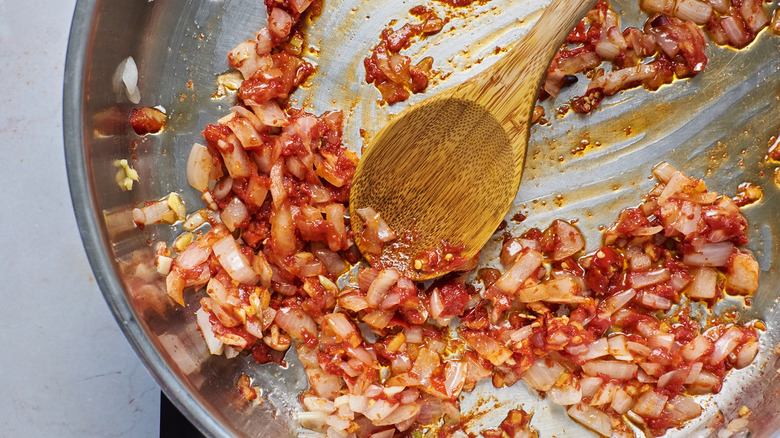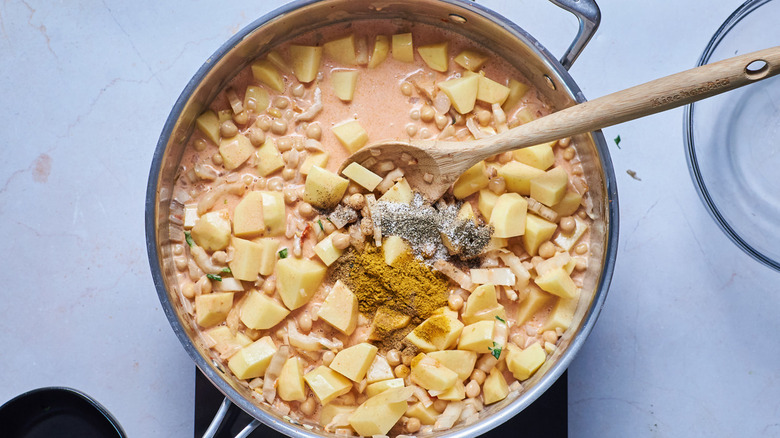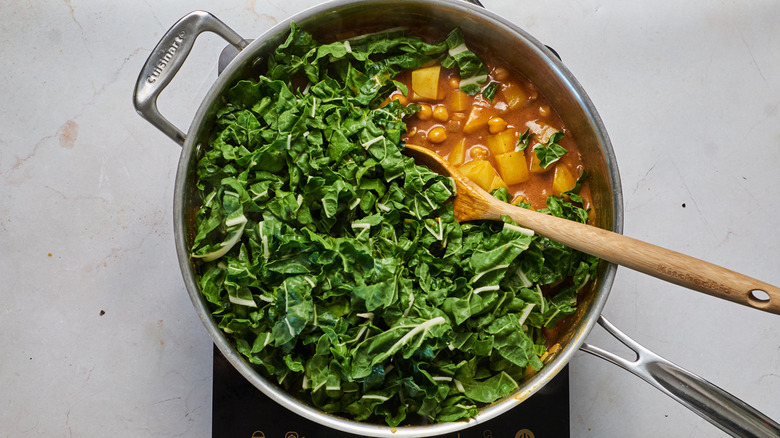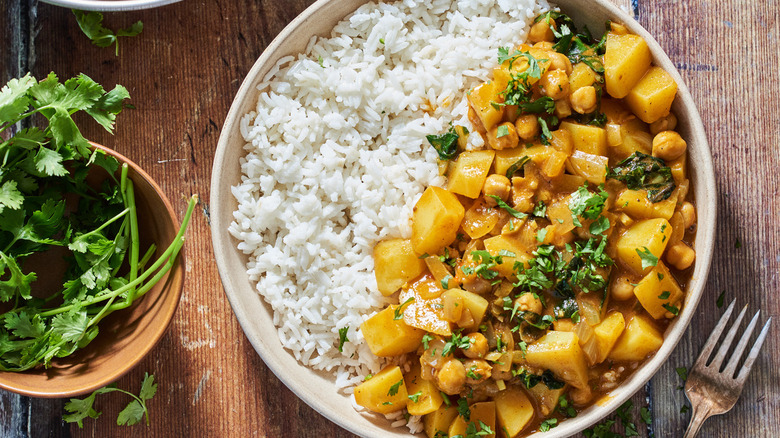Swiss Chard Coconut Curry Recipe
When you think of all the ingredients that might be found in a curry, it's likely that Swiss chard isn't the first thing to pop up. That said, the leafy green has a welcome place in a comforting bowl of curry, adding not only a vibrant pop of color but also providing a mild, earthy flavor that complements the other components of this dish. Recipe developer Michelle McGlinn has crafted this recipe for Swiss chard coconut curry and says, "I'm a big fan of leafy greens — even the bitter ones — and love adding them to soups, salads, and curries." After giving this recipe a try, something tells us that you'll also be looking for more ways to incorporate the verdant vegetable.
Like spinach, Swiss chard will wilt down significantly when cooked, so McGlinn appreciates the fact that you can pack quite a few greens into the curry and it won't feel overrun by vegetables. "Curry is a great way to incorporate a big green like Swiss chard because it offers a great flavor and texture," she explains. "You don't feel like you're eating several cups of chard!" Other components of this curry include potatoes, chickpeas, and as the name suggests, coconut milk, making for a vegan dish that will fill you up and ensure you get your daily dose of veggies.
Gather the ingredients for Swiss chard coconut curry
You'll need plenty of pantry and spice staples for this recipe, including oil, curry powder, garam masala, coriander, salt, and pepper. The bulk of the curry is made up by Yukon gold potatoes, chickpeas, a yellow onion, tomato paste, coconut milk, Thai chiles (McGlinn recommends omitting these if you don't like spice, or adding even more if you love spice), ginger, garlic, and of course, the Swiss chard. "You can use rainbow chard, spinach, or kale instead, if Swiss chard isn't available near you," McGlinn notes. "Swiss chard is the super-leafy vegetable with white stalks — rainbow chard will have red, yellow, and white, but tastes almost identical." That said, she advises against opting for collard, mustard, or turnip greens, as their bitter flavor will impact the dish a bit too much. We're going for a mild earthy flavor, not an overbearingly bitter one. And, speaking of greens, do have some fresh cilantro on hand, which will serve as a garnish for the curry.
Prep the Swiss chard
If you've never cooked with Swiss chard before, you may be tempted to ditch the stalks and just use the leaves, but you'll actually use both components in this recipe. "To prepare the chard, fold the leaves in half lengthwise and slice away the white stalk," McGlinn explains. While she calls to chiffonade the leaves, she does note that you can simply tear them up with your hands, but either way, they do need to be broken down. If you opt for the chiffonade route, McGlinn walks us through the process: "Slice the leaves into quarters (otherwise the chiffonade pieces will be super long) and roll into little tubes. Slice the tubes into ½-inch pieces. This will result in long, thin pieces of chard, which will cook down to easy bite-size pieces."
As for those stalks, you can simply chop them into small pieces, as you would stalks of celery. Keep in mind that the stalks will need more time to cook than the leaves, so you'll be adding the chard components into the pot at different points.
Begin building the curry
Place a large, deep skillet or pot on the stovetop over medium heat. Add in the oil and once hot, minced garlic, diced onion, and minced ginger. Cook until slightly softened and plenty fragrant, about 2 minutes, then add in the tomato paste, Swiss chard stalks, and chopped chiles, using the back of a spoon to really incorporate the tomato paste. Cook for another 3 minutes.
Add the potatoes, chickpeas, and spices
Mix the coconut milk into the pot, and don't be too alarmed by the pink color it makes in combination with the tomato paste — it's normal, and thanks to the soon-to-be-added spices, that color will go from pink to golden. Next up, submerge the potatoes and chickpeas into the mix, then add the spices: curry powder, garam masala, cumin, coriander, salt, and pepper. Stir it all up then put a lid on the pot, leaving the curry to simmer on medium-low heat for 20 minutes.
Stir in the Swiss chard leaves
Once the 20 minutes is up, it's possible that the coconut milk has thickened up quite a bit, in which case you may need to add some water. "The water may not be necessary, so it is optional. It will depend on the type of coconut milk used and the heat," McGlinn explains. "I've used coconut milks that have a high water content and barely thicken, and coconut milks that are so thick, they could be peanut butter." No big deal if so, simply add splashes of water (up to ½ cup) until you reach a thinner consistency. "You could also use more coconut milk, chicken or vegetable broth, or even some heavy cream," McGlinn notes.
Now, in goes the Swiss chard, and it won't take long to cook at all. Add the sliced leaves into the mix, pop the lid back on, and allow the chard to steam for 2 minutes, or until it turns bright green. All that's left to do is season to taste with salt and pepper, and don't be afraid to get liberal with the former. "If, at the end, the curry is bland, add more salt," McGlinn advises, explaining that it will help amp up the curry powder and garam masala. "You can, of course, always add more curry powder or garam masala," she says, "but it's likely you just need a pinch or two more of salt!"
Garnish with cilantro and serve
This curry pairs well with rice, so spoon some into a bowl with a big heap of white rice, sprinkle on cilantro, and enjoy. "For side dishes, I really like samosas, or this would go well with fried eggplant (baigan bhaja)," McGlinn suggests. "If incorporating meat into the meal, this goes well with roast chicken or braised lamb." You also can't go wrong with scooping up some of that sauce with naan, or just enjoy a warming bowl on its own — you'll soon forget that you're getting a huge dose of greens as you do so.
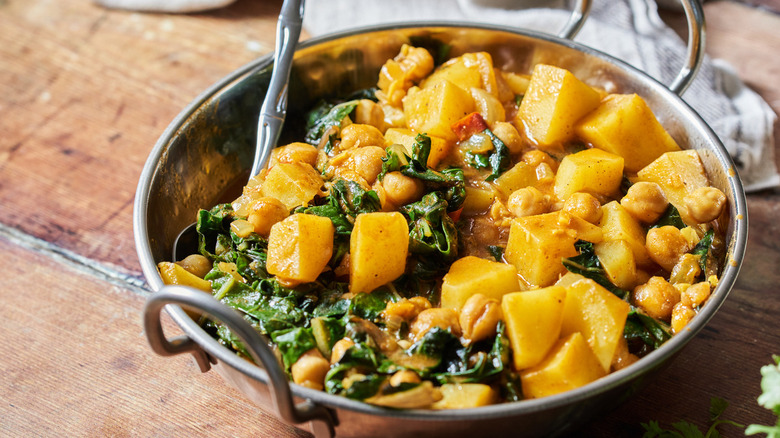
- 2 tablespoons oil
- 3 cloves garlic, minced
- 1 small yellow onion, finely diced
- 1-inch fresh ginger, peeled and minced
- ¼ cup tomato paste
- 5-6 stalks Swiss chard, stalks cut into 1-inch pieces, leaves chiffonaded
- 3 Thai chiles, finely chopped
- 1 (13 ½-ounce) can coconut milk
- 1 ½ pounds Yukon gold potatoes, peeled and cut into 1-inch pieces
- 1 (15 ½-ounce) can chickpeas
- 2 tablespoons curry powder
- 1 teaspoon garam masala
- 1 teaspoon cumin
- ½ teaspoon coriander
- 1 teaspoon each salt and pepper, plus more to taste
- ½ cup water
- cilantro, for garnish
- Heat the oil in a deep skillet or pot over medium heat. Once hot, add the garlic, onions, and ginger and cook until soft and fragrant, about 2 minutes. Add the tomato paste, Swiss chard stalks, and chiles and combine, using the back of a spoon to incorporate the tomato paste. Cook until tomato paste is beginning to stick to the bottom of the pot, about 3 more minutes.
- Stir in the coconut milk until mixture is smooth and tomato paste is incorporated. Add the potatoes and chickpeas and submerge as much as possible, then add the curry powder, garam masala, cumin, coriander, salt, and pepper. Stir to combine, then cover and cook on medium low heat until potatoes have softened, about 20 minutes.
- If coconut milk has thickened, add water to thin until desired consistency is reached. Once potatoes are fork-tender, add the Swiss chard leaves and stir into the curry, then cover and steam on medium low heat until leaves are bright green and soft, about 2 minutes.
- Season to taste with salt and pepper. To serve, sprinkle with cilantro.

